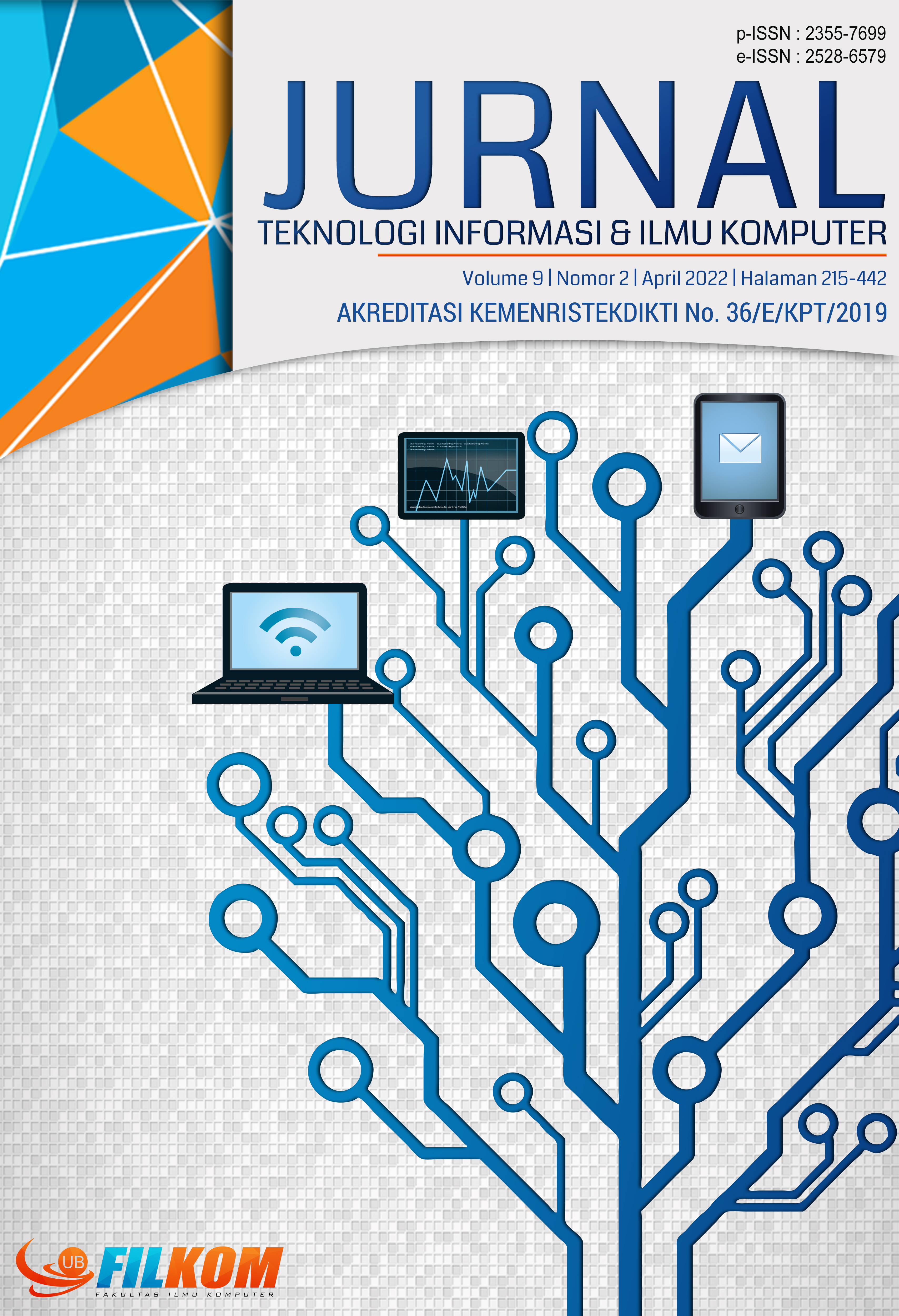Pengaruh Word Affect Intensities Terhadap Deteksi Ulasan Palsu
DOI:
https://doi.org/10.25126/jtiik.2022925652Abstrak
Transaksi jual beli elektronik melalui internet terus berkembang dan menjadi populer, begitu pula dengan jumlah ulasan dari pelanggan yang meningkat pesat. Dengan banyaknya pemberi ulasan, terdapat kemungkinan seseorang menulis ulasan palsu yang disebut fake review untuk mempromosikan produk atau menjatuhkan produk kompetitor. Sangat penting untuk dapat mendeteksi ulasan palsu sehingga ulasan yang digunakan pelanggan sebagai pertimbangan untuk memilih produk atau jasa merupakan ulasan yang andal. Studi sebelumnya hanya menggunakan fitur sentimen yang terbatas pada objektivitas dan polaritas untuk melakukan deteksi ulasan palsu. Sedangkan studi yang lebih baru menunjukan adanya leksikon kosa kata berbasis emosi yang diberi nama word affect intensities yang terbukti mampu mengukur sentimen dengan lebih baik pada kalimat. Penelitian ini bermaksud untuk mengetahui apakah word affect intensities dapat menjadi faktor yang mempengaruhi hasil deteksi ulasan palsu. Penelitian dilakukan dengan memunculkan dua fitur baru berlandaskan word affect intensities berupa fitur kelompok emosi positif dan fitur kelompok emosi negatif. Fitur tersebut kemudian dikombinasikan dengan fitur pada penelitian sebelumnya dan dievaluasi menggunakan beberapa algoritme klasifikasi. Hasil penelitian menunjukan word affect intensities dapat menjadi faktor yang mempengaruh peningkatan akurasi deteksi ulasan palsu sebesar 2.1%.
Abstract
Electronic buying and selling transactions over the internet continue to grow and become popular, as well as the number of reviews from customers that is increasing rapidly. With so many reviewers, it is possible that someone wrote a fake review to promote a product or demote a competitor’s product. It is very important to be able to detect fake review so that the reviews customers use as a consideration for choosing a product or service are reliable reviews. Previous studies only used sentiment features that were limited to objectivity and polarity to detect fake review. Meanwhile, a more recent study shows that there is an emotion-based vocabulary lexicon called word affect intensities which are proven to be able to better measure sentiment in sentences. This study intends to determine whether word affect intensities can be a factor that affects the results of fake review detection. The research was conducted by bringing up two new features based on the word affect intensities in the form of positive emotion group features and negative emotion group features. These features are then combined with features in previous studies and evaluated using several classification algorithms. The results showed that word affect intensities can be a factor that affects the increased accuracy of fake review detection by 2.1%.
Downloads
Referensi
ASLAM, U., JAYABALAN, M., ILYAS, H. dan SUHAIL, A., 2019. A Survey on Opinion Spam Detection Methods. International Journal of Scientific & Technology Research, 8(9), pp.1355.
BUECHEL, S. dan HAHN, U., 2018. Representation Mapping: A Novel Approach to Generate High-Quality Multi-Lingual Emotion Lexicons. Proceedings of the 11th International Conference on Language Resources and Evaluation, pp.184-191.
CAMBRIA, E., PORIA, S., HAZARIKA, D. dan KWOK, K., 2018. SenticNet 5: Discovering Conceptual Primitives for Sentiment Analysis by Means of Context Embeddings. The Thirty-Second AAAI Conference on Artificial Intelligence, pp.1795-1802.
HARYONO, D.A. dan BACHTIAR, F.A., 2020. Klasifikasi Ulasan Palsu Menggunakan MDLText dengan Seleksi Fitur IG dan SMOTE. Jurnal Pengembangan Teknologi Informasi dan Ilmu Komputer, 4(5), pp. 1536-1545.
LI, F., HUANG, M., YANG, Y. dan ZHU, X., 2010. Learning to Identify Review Spam. Proceedings of the Twenty-Second International Joint Conference on Artificial Intelligence, pp.2488-2493.
MOHAMMAD, S.M., 2018. Word Affect Intensities. Proceedings of the Eleventh International Conference on Language Resource and Evaluation (LREC 2018). Miyazaki, Japan.
MUNOZ-DE-ESCALONA, E. dan CANAS, J.J., 2017. Online Measuring of Available Resources. The first international symposium on human mental workload. Dublin, Ireland.
OTT, M., CARDIE, C. dan HANCOCK, J.T., 2013. Negative Deceptive Opinion Spam. Proceedings of NAACL-HLT 2013, pp.497-501.
PAUL, H. dan NIKOLAEV, A., 2021. Fake review detection on online E-commerce platforms: a systematic literature review. Data Mining and Knowledge Discovery. https://doi.org/10.1007/s10618-021-00772-6
Unduhan
Diterbitkan
Terbitan
Bagian
Lisensi

Artikel ini berlisensi Creative Common Attribution-ShareAlike 4.0 International (CC BY-SA 4.0)
Penulis yang menerbitkan di jurnal ini menyetujui ketentuan berikut:
- Penulis menyimpan hak cipta dan memberikan jurnal hak penerbitan pertama naskah secara simultan dengan lisensi di bawah Creative Common Attribution-ShareAlike 4.0 International (CC BY-SA 4.0) yang mengizinkan orang lain untuk berbagi pekerjaan dengan sebuah pernyataan kepenulisan pekerjaan dan penerbitan awal di jurnal ini.
- Penulis bisa memasukkan ke dalam penyusunan kontraktual tambahan terpisah untuk distribusi non ekslusif versi kaya terbitan jurnal (contoh: mempostingnya ke repositori institusional atau menerbitkannya dalam sebuah buku), dengan pengakuan penerbitan awalnya di jurnal ini.
- Penulis diizinkan dan didorong untuk mem-posting karya mereka online (contoh: di repositori institusional atau di website mereka) sebelum dan selama proses penyerahan, karena dapat mengarahkan ke pertukaran produktif, seperti halnya sitiran yang lebih awal dan lebih hebat dari karya yang diterbitkan. (Lihat Efek Akses Terbuka).












